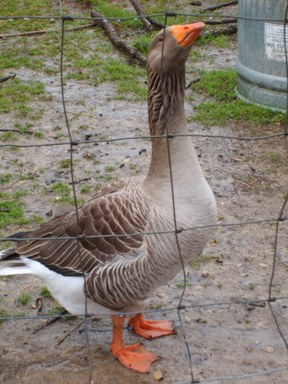The Toulouse is a very old breed of barnyard geese. They originated in France, were brought to England in the late 1700's and to America in the mid-1800's. They are one of the largest domestic geese, weighing over 20 lbs, and are sometimes used for meat production. They are cold hardy and good foragers, finding all their own food except in the hardest months of winter, when we supplement their diet with corn. They are sometimes called the "watchdogs of the barnyard" because their loud honking will alert farmers to anything out of the ordinary, be it visitors in the driveway or coyotes near the livestock. Our geese are not aggressive unless defending their nests in the spring. A Toulouse goose can lay up to 20 eggs in the spring, and must sit on them for a month to hatch goslings. The goslings can swim from birth and the entire flock spends much time on our pond. While the young will mature in less than a year, these birds can live to be over 100 years old. This information was taken from http://pleasantvalleyfarm.weebly.com
African geese are not from Africa! They are the same color as the Chinese goose, and originated in SE China. Like the Brown Chinese, they are the same color as the wild swan goose. They were imported into the USA in the nineteenth century, and reached Britain too as the 'Hong Kong' goose in Victorian times. Good examples of the African were more or less lost in the UK in the 20th century. Most Africans here now come from birds imported from the USA from the 1970s onwards. Exhibition Africans are imposing birds, ganders standing one meter tall. Hand reared, they are very tame. There is a great deal of variation in weight. Some varieties are quite small, reaching only 16-20 lbs. Big exhibition birds in the UK and the USA reach 26 lbs - the same as their stated weight in SE China. This information was taken from http://www.ashtonwaterfowl.net .





